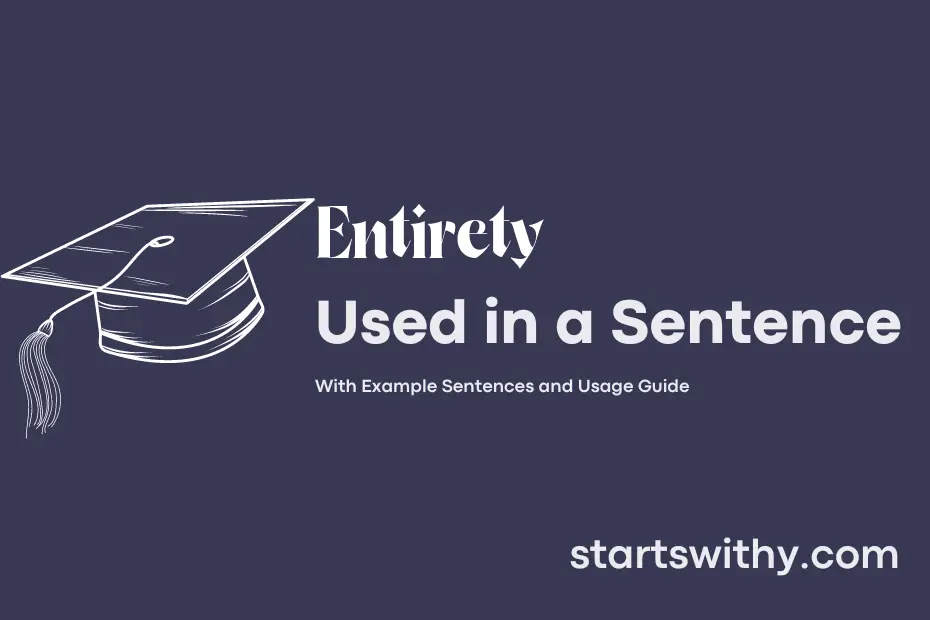Have you ever wondered how to use the word “entirety” correctly in a sentence? “Entirety” is a noun that refers to the whole or complete extent of something, encompassing all parts without exception.
In grammar, “entirety” is often used to emphasize that something is being considered in its entirety, without any parts or aspects being overlooked. Understanding how to use “entirety” in a sentence can help convey a sense of completeness or wholeness in your writing.
7 Examples Of Entirety Used In a Sentence For Kids
- The entirety of the class is listening to the teacher.
- The entirety of the book is filled with colorful pictures.
- We must clean up the entirety of our classroom before leaving.
- Let’s count the entirety of the crayons in the box.
- The entirety of the puzzle has been completed!
- We need to share our toys with the entirety of our friends.
- It’s important to pay attention to the entirety of the story during storytime.
14 Sentences with Entirety Examples
- Entirety of my assignment was plagiarized, resulting in a failing grade.
- I need to study the entirety of this textbook before the exam next week.
- I attended the lecture in its entirety to ensure I didn’t miss any important information.
- I spent the entirety of last night studying for my final exams.
- The professor emphasized the importance of reading the syllabus in its entirety.
- I struggled to focus on the lecture for the entirety of the class period.
- It’s crucial to understand the entirety of the assignment instructions to avoid mistakes.
- I regret not attending the tutorial session in its entirety last week.
- The library was packed with students studying for the entirety of the afternoon.
- I plan to revise the course material in its entirety over the weekend.
- The professor assigned a research paper that will require the entirety of the semester to complete.
- I managed to finish my project in its entirety just before the deadline.
- I wish I had paid attention to the lecture in its entirety instead of getting distracted.
- It’s important to manage your time effectively in order to complete assignments in their entirety.
How To Use Entirety in Sentences?
To use Entirety in a sentence, start by identifying the subject of the sentence. Entirety is a noun that refers to the whole thing, the complete state, or the full extent of something.
Next, determine what you want to convey with your sentence. If you want to express that something is complete, total, or whole, you can incorporate Entirety to emphasize that idea. For example, “She read the book in its entirety, without skipping any pages” or “I watched the movie in its entirety, from beginning to end.”
It’s important to place Entirety correctly in the sentence to ensure clear communication. You can use it at the beginning, middle, or end of a sentence depending on the emphasis you want to give it. Just remember that it should relate directly to the idea of completeness or wholeness.
Lastly, make sure the rest of your sentence supports the use of the word Entirety and conveys your intended meaning effectively. Avoid using it in a way that may cause confusion or disrupt the flow of your sentence.
With practice, you’ll become more comfortable incorporating Entirety into your sentences to convey the sense of entirety or completeness you intend.
Conclusion
In conclusion, by examining sentences employing the keyword “entirety,” it is evident that this term denotes a sense of wholeness and completeness. Whether describing a situation, concept, or object, sentences incorporating “entirety” underscore the idea of totality without any missing parts or elements. By using this word, writers and speakers emphasize the inclusivity and comprehensiveness of the subject in question.
Through a variety of examples provided in this article, it is clear that sentences featuring the word “entirety” serve to emphasize the full extent and complete nature of a given entity. By encapsulating the entirety of a subject, these sentences effectively convey a sense of unity and integrity, leaving no room for ambiguity or partiality in the understanding of the matter at hand.



